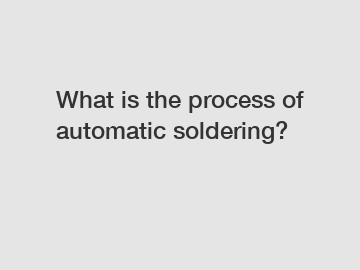What is the process of automatic soldering?
What is the process of automatic soldering? This article will delve into the intricacies of automatic soldering, explaining its origin, the process of its execution, and its significance and impact in various industries.
Origin and Evolution of Automatic Soldering:
Automatic soldering refers to the technique of joining two or more metallic components using a filler metal, called solder, which melts at a lower temperature than the workpiece. The concept of soldering dates back thousands of years, but the automation of this process gained prominence with the advancement of technology in the industrial era. The need for efficient and reliable solder joints in mass production led to the development of automated soldering machines.

The Process of Automatic Soldering:
Automatic soldering involves a series of carefully orchestrated steps. First, the components to be soldered are securely positioned in place using mechanical fixtures or clamps. This ensures precise alignment and stability during the soldering process. Next, the soldering machine deploys a controlled amount of heat to melt the solder, which then flows onto the soldering point or joint. The heat source can be a soldering iron, a laser, or an induction heater, depending on the specific requirements of the application. After the solder cools and solidifies, the joint is completed, resulting in a strong and enduring connection.
Significance and Impact of Automatic Soldering:
1. Enhanced Efficiency: Automatic soldering eliminates the need for manual labor, allowing for increased production speed and efficiency. These machines can perform repetitive tasks tirelessly, reducing human error and increasing overall productivity.
2. Consistency and Precision: By precisely controlling the temperature, time, and flow of solder, automatic soldering machines ensure consistent and accurate results. This level of precision is crucial in industries where even the smallest variations can impact product quality and reliability.
3. Cost-effectiveness: While the initial investment in automatic soldering equipment may be substantial, the long-term benefits outweigh the costs. Reduced labor requirements, improved productivity, and higher-quality solder joints contribute to overall cost savings for manufacturers.
4. Safety and Reliability: Automated soldering minimizes the risk of human accidents, such as burns or exposure to toxic fumes. Additionally, the reliability and consistency of automated soldering lead to durable and structurally sound connections, reducing the chances of product failure or malfunction.
Conclusion:
The process of automatic soldering has evolved from a traditional manual technique to a sophisticated and efficient method of joining metallic components. By eliminating human error and increasing precision, this technology offers unparalleled benefits in terms of productivity, cost-effectiveness, and safety. As industries continue to advance, automatic soldering plays a pivotal role in ensuring reliable connections and high-quality manufactured goods.
If you are looking for more details, kindly visit AB dual glue dispensing machine, CCD positioning screw driving robot, automated riveting machine.

Comments
0